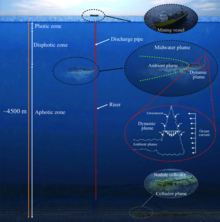
Back تعدين في قاع البحر Arabic Mineria abissal Catalan Dybhavsminedrift Danish Meeresbodenbergbau German Minería en el fondo del mar Spanish Itsaso sakoneko meatzaritza Basque Syvänmeren kaivaus Finnish Exploitation minière des fonds marins French כרייה במים עמוקים HE Mélytengeri bányászat Hungarian

Deep sea mining is the extraction of minerals from the ocean floor at depths of 200 metres (660 ft)[2][3] to 6,500 metres (21,300 ft).[4][5][6]
Deep-sea mining uses hydraulic pumps or bucket systems that carry deposits to the surface for processing.
The environmental impact of deep sea mining is controversial.[7][8] Environmental advocacy groups such as Greenpeace and the Deep Sea Mining Campaign[9] claimed that seabed mining has the potential to damage deep sea ecosystems and spread pollution from heavy metal-laden plumes.[10] Critics have called for moratoria[11][12] or permanent bans.[13] Opposition campaigns enlisted the support of some industry figures, including firms reliant on the target metals. Individual countries with significant deposits within their exclusive economic zones (EEZ's) are exploring the subject.[14][15]
As of 2022, no commercial deep sea mining was underway. However, the International Seabed Authority granted 19 exploration licenses for polymetallic nodules within the Clarion Clipperton Zone.[16] China has exclusive rights to mine 92,000 square miles (240,000 km2) or 17 percent of the area. Mining is set to begin in 2025.[17] In 2022 the Cook Islands Seabed Minerals Authority (SBMA) granted 3 exploration licenses for polymetallic nodules within their EEZ.[18] Papua New Guinea was the first country to approve a DSM permit, to Solwara 1, even though three independent reviews of the environmental impact statement mine alleged significant gaps and flaws in the underlying science.[19]
Related technologies include robotic mining machines, as surface ships, and offshore and onshore metal refineries.[20][21]
Wind farms, solar energy, electric cars, and battery technologies use many of the deep-sea metals.[20]
As of 2021, the majority of marine mining used dredging operations at depths of about 200 m, where sand, silt and mud for construction purposes is abundant, along with mineral rich sands containing ilmenite and diamonds.[22][23]
- ^ Muñoz-Royo, Carlos; Peacock, Thomas; Alford, Matthew H.; Smith, Jerome A.; Le Boyer, Arnaud; Kulkarni, Chinmay S.; Lermusiaux, Pierre F. J.; Haley, Patrick J.; Mirabito, Chris; Wang, Dayang; Adams, E. Eric; Ouillon, Raphael; Breugem, Alexander; Decrop, Boudewijn; Lanckriet, Thijs (27 July 2021). "Extent of impact of deep-sea nodule mining midwater plumes is influenced by sediment loading, turbulence and thresholds". Communications Earth & Environment. 2 (1): 1–16. doi:10.1038/s43247-021-00213-8. hdl:1721.1/138864.2. ISSN 2662-4435.
- ^ "Seabed Mining". The Ocean Foundation. 7 August 2010. Archived from the original on 28 February 2021. Retrieved 2 April 2021.
- ^ "SPC-EU Deep Sea Minerals Project - Publications and Reports". dsm.gsd.spc.int. Archived from the original on 6 September 2021. Retrieved 6 September 2021.
- ^ SITNFlash (26 September 2019). "The Next Gold Rush: Mining in the deep sea". Science in the News. Archived from the original on 4 October 2022. Retrieved 17 February 2023.
- ^ Poston, Jonathan. "Deeperminers". site name. Archived from the original on 19 January 2023. Retrieved 17 February 2023.
- ^ Nascimento, Decio. "Council Post: Could Deep-Sea Mining Rescue The Future Of The Renewable Transition?". Forbes. Archived from the original on 6 December 2022. Retrieved 17 February 2023.
- ^ Kim, Rakhyun E. (August 2017). "Should deep seabed mining be allowed?". Marine Policy. 82: 134–137. doi:10.1016/j.marpol.2017.05.010.
- ^ Costa, Corrado; Fanelli, Emanuela; Marini, Simone; Danovaro, Roberto; Aguzzi, Jacopo (2020). "Global Deep-Sea Biodiversity Research Trends Highlighted by Science Mapping Approach". Frontiers in Marine Science. 7: 384. doi:10.3389/fmars.2020.00384. hdl:10261/216646.
- ^ Rosenbaum, Dr. Helen (November 2011). "Out of Our Depth: Mining the Ocean Floor in Papua New Guinea". Deep Sea Mining Campaign. MiningWatch Canada, CELCoR, Packard Foundation. Archived from the original on 13 December 2019. Retrieved 2 May 2020.
- ^ Halfar, Jochen; Fujita, Rodney M. (18 May 2007). "Danger of Deep-Sea Mining". Science. 316 (5827): 987. doi:10.1126/science.1138289. S2CID 128645876.
- ^ "Collapse of PNG deep-sea mining venture sparks calls for moratorium". the Guardian. 15 September 2019. Archived from the original on 11 April 2021. Retrieved 2 April 2021.
- ^ "David Attenborough calls for ban on 'devastating' deep sea mining". the Guardian. 12 March 2020. Archived from the original on 6 September 2021. Retrieved 6 September 2021.
- ^ "Google, BMW, Volvo, and Samsung SDI sign up to WWF call for temporary ban on deep-sea mining". Reuters. 31 March 2021. Archived from the original on 6 September 2021. Retrieved 6 September 2021.
- ^ "SPC-EU Deep Sea Minerals Project - Home". dsm.gsd.spc.int. Archived from the original on 6 September 2021. Retrieved 6 September 2021.
- ^ "The Environmental Protection Authority (EPA) has refused an application by Chatham Rock Phosphate Limited (CRP)". Deepwater group. 2015. Archived from the original on 24 January 2016. Retrieved 6 September 2021.
- ^ "Exploration Contracts | International Seabed Authority". isa.org.jm. Archived from the original on 5 February 2021. Retrieved 6 September 2021.
- ^ Kuo, Lily (19 October 2023). "China is set to dominate the deep sea and its wealth of rare metals". Washington Post. Retrieved 14 February 2024.
- ^ "Cook Islands Seabed Minerals Authority - Map". Archived from the original on 30 June 2022. Retrieved 6 July 2022.
- ^ "Campaign Reports | Deep Sea Mining: Out Of Our Depth". 19 November 2011. Archived from the original on 13 December 2019. Retrieved 6 September 2021.
- ^ a b SPC (2013). Deep Sea Minerals: Deep Sea Minerals and the Green Economy Archived 2021-11-04 at the Wayback Machine. Baker, E., and Beaudoin, Y. (Eds.) Vol. 2, Secretariat of the Pacific Community
- ^ "Breaking Free From Mining" (PDF). Archived from the original (PDF) on 23 December 2021.
- ^ John J. Gurney, Alfred A. Levinson, and H. Stuart Smith (1991) Marine mining of diamonds off the West Coast of Southern Africa, Gems & Gemology, p. 206
- ^ "Seabed Mining". The Ocean Foundation. 7 August 2010. Archived from the original on 8 September 2021. Retrieved 6 September 2021.